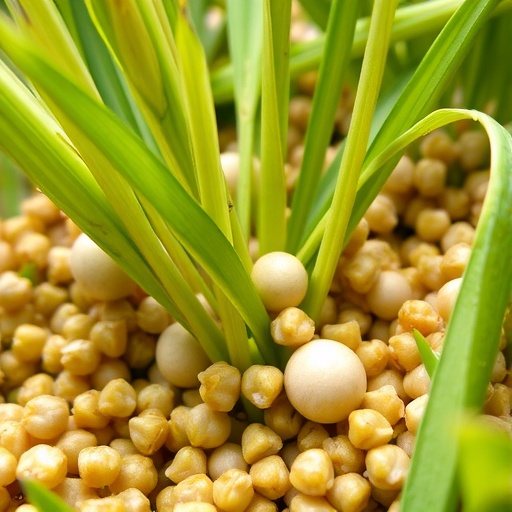In a groundbreaking study, researchers have unveiled the intricate dynamics of the rice leaf phyllomicrobiome and its response to biological threats, particularly the devastating fungal pathogen, Magnaporthe oryzae. This pathogen is notorious for causing rice blast disease, which can lead to substantial reductions in rice yield worldwide. Understanding the relationship between this pathogen and the plant’s microbial community is crucial for developing sustainable agricultural practices and enhancing crop resilience.
The research team conducted a comprehensive analysis utilizing advanced metabarcoding techniques, which allowed them to identify and categorize the diverse microbial organisms present on the rice leaves. This approach revealed previously unrecognized complexities within the phyllomicrobiome, highlighting the essential role that microbial communities play in plant health and disease resistance. By documenting the shifts in microbial populations associated with Magnaporthe oryzae infection, the researchers provided a fuller picture of the ecological interactions at play.
One of the study’s significant findings was the identification of dysbiosis in the rice leaf microbiome when exposed to the Rice blast pathogen. Dysbiosis is defined as an imbalance in the microbial community, which can lead to weakened defenses against pathogens. The overgrowth of certain microbial taxa and the loss of beneficial ones suggested that Magnaporthe oryzae manipulation of the phyllomicrobiome is an adaptive strategy to facilitate its survival and spread. These insights are particularly relevant in the context of global food security, as rice is a staple food for more than half of the world’s population.
The research emphasizes the importance of maintaining a healthy phyllomicrobiome to foster plant resilience against pathogens. The findings suggest that promoting beneficial microbiota could be a viable strategy to enhance rice plants’ natural defenses. This could involve practices like the application of biocontrol agents, which are beneficial microbes that can suppress the growth of pathogens and promote plant health.
Furthermore, the study leveraged microbiome imprinting techniques, which involve understanding how a plant’s microbiome is influenced by environmental factors and pathogen interactions over time. This methodology allowed for the assessment of long-term effects of M. oryzae on the rice phyllomicrobiome, painting a clearer picture of how microbial assemblages evolve in response to ongoing biotic stress. By examining these long-term dynamics, researchers can better predict the outcomes of future plant-pathogen interactions.
The implications of this research extend beyond rice cultivation. The principles gleaned from this study may inform practices in other crops facing similar microbial challenges. As global agriculture grapples with increasing pest and disease pressures exacerbated by climate change, strategies honed from understanding the rice-phyllomicrobiome relationship could aid in developing more resilient agricultural systems across various crops.
Moreover, this research aligns with increasing recognition of microbial communities’ roles in promoting sustainable agricultural methods. By focusing on biological solutions, such as the enhancement of beneficial microorganisms, farmers might reduce reliance on chemical pesticides, which can have detrimental effects on the environment and human health.
The findings from this study add a significant layer to our understanding of plant-microbe interactions. As researchers continue to explore the complexities of phyllomicrobiomes, we may discover additional pathways through which plants can communicate, adapt, and combat diseases, reshaping our approaches to crop management and protection.
Conclusively, the intricate relationship between rice leaves and their microbial communities offers an avenue for innovation in sustainable agriculture. As the field of microbiome research expands, the potential for utilizing beneficial microbes to combat plant diseases becomes increasingly apparent. The study highlights a crucial frontier in agricultural science that promises to enhance food security and promote environmental sustainability.
This research marks a pivotal moment in our understanding of phyllomicrobial dynamics, providing a roadmap for future investigations aimed at unraveling the complexities of plant microbiomes everywhere. With the rice leaf phyllomicrobiome serving as a model, we anticipate further studies that will uncover the vast potential harboring in microbial communities across various ecosystems.
As the looming threat of pathogens continues to challenge food production systems, advancing our understanding of plant-microbe interactions becomes paramount. The knowledge garnered from such research will not only contribute to enhancing crop defenses but also lay the groundwork for innovative agricultural practices that align with ecological principles, ensuring that future generations can enjoy a secure food supply.
In summary, the dysbiosis observed in the rice leaf phyllomicrobiome due to Magnaporthe oryzae highlights the delicate balance of microbial ecosystems and the significant role they play in plant health. This research offers a promising perspective on how we can utilize microbial communities to bolster plant defenses and combat disease, underscoring the importance of preserving and enhancing these essential interactions in agricultural settings.
Subject of Research: Dysbiosis of the rice leaf phyllomicrobiome induced by Magnaporthe oryzae infection
Article Title: Dysbiosis of the rice leaf phyllomicrobiome induced by Magnaporthe oryzae infection: evidence from metabarcoding and microbiome imprinting.
Article References:
Krishnappa, C., Sahu, K.P., Ashajyothi, M. et al. Dysbiosis of the rice leaf phyllomicrobiome induced by Magnaporthe oryzae infection: evidence from metabarcoding and microbiome imprinting.
Int Microbiol (2025). https://doi.org/10.1007/s10123-025-00691-2
Image Credits: AI Generated
DOI: https://doi.org/10.1007/s10123-025-00691-2
Keywords: dysbiosis, rice phyllomicrobiome, Magnaporthe oryzae, metabarcoding, microbiome imprinting, sustainable agriculture, plant health, microbial communities.




